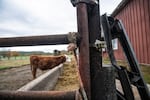
Eight states have a confirmed case of bird flu on dairy cattle herds. U.S. Department of Agriculture officials say wild migratory birds are the likely source of infection on the cattle.
Lance Cheung / U.S. Department of Agriculture
So far, eight states across the country have reported cases of highly pathogenic avian influenza, or simply bird flu, in dairy cattle herds — including Idaho. There are no active cases in Oregon, but farmers and officials have started taking precautions.
The strain, novel avian influenza H5N, is the same flu strain that has affected millions of poultry birds across the U.S. since 2022, including nearly 800,000 commercial chickens in Oregon, and several backyard flocks, according to the U.S. Department of Agriculture.
The virus was first detected in late March in two dairy herds in Texas and two in Kansas. Those infections mark the first time bird flu has been detected in dairy cattle, according to the American Veterinary Medical Association.
What’s the risk to dairy cows and humans?
USDA officials say wild migratory birds are believed to be the original source of the virus, though officials say in some cases, the virus may have been transmitted between cows. An analysis of the virus in cattle suggests it has not mutated or become more transmissible to humans. Although it is possible, unless a person is in prolonged contact with a sick animal, it’s rare for a person to contract the virus, according to the Centers for Disease Control and Prevention.
While the virus is fatal for birds, cows tend to recover on their own, and milk supplies are still safe, said Jenifer Cruickshank, an Oregon State University dairy specialist and assistant professor.
“Influenza viruses, and most viruses honestly, are really easily killed by pasteurization,” Cruickshank said. “And the milk supply, there’s absolutely zero concern about the safety of the milk supply.”
Milk from impacted animals is being diverted or destroyed so that it does not enter the food supply, according to the USDA.
How is Oregon responding?
As a precaution, the Oregon Department of Agriculture recently set some restrictions for cattle coming from states where the virus has been found in dairy herds. Dairy cattle will need an import permit issued by the state and a veterinary inspection before coming into the state. Cruickshank said, however, state-to-state movement of dairy cows to Oregon is uncommon. Other states with similar movement restrictions include California and Idaho.
The state’s department of agriculture is suggesting farmers practice what it calls “good biosecurity,” like minimizing dairy livestock movements and isolating sick cows from the herd if they show symptoms like loss of appetite or a drop in milk production.
Tami Kerr, the executive director of the Oregon Dairy Farmers Association — an industry trade group — said while the risk of infection in cows is still low, concerns about bird flu present a challenge to dairy producers.
“I think it heightens awareness, and there’s already an awful lot of challenges being a dairy farmer. You don’t control the price of your milk and all the other expenses have risen substantially over the last five years,” Kerr said. “COVID had a very negative impact on our supply chain, and it really increased a lot of costs. There’s a lot of things that are out of control of our dairy farmers.”
Cruickshank added that sick cows can be an economic hit for farmers, although what’s most uncertain for now are the long-term effects of the virus.
“The long-term concern is the potential for mutation of the virus to either be more pathogenic, having more severe consequences or becoming more transmissible,” Cruickshank.
